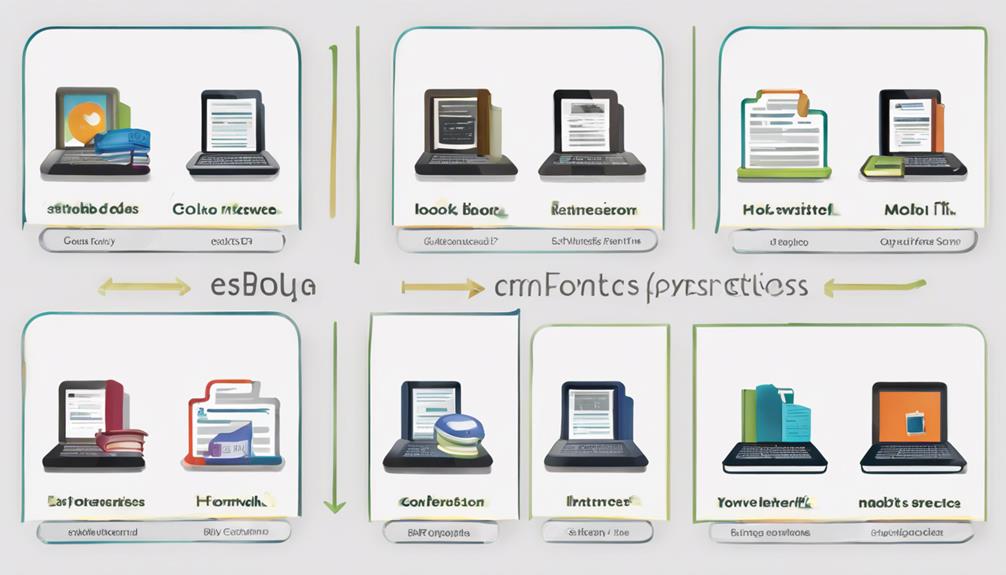So, you’ve decided to take the leap and digitize your book collection. But where do you start? From selecting the right conversion service to organizing your digital files effectively, there are several crucial steps to consider. By following a methodical approach and paying attention to detail, you can ensure that your beloved books are preserved in a digital format for future generations to enjoy. But before we get into the nitty-gritty, let’s first explore the initial stages of this exciting journey.
Select a Conversion Service
When considering digitizing your book collection, selecting a conversion service is a crucial step towards preserving your literary treasures in a digital format. Two essential factors to consider when choosing a conversion service are cost comparison and quality assurance.
Cost comparison is important as it allows you to evaluate different service providers and choose one that fits your budget. Some services may offer bulk discounts or additional perks, so it’s wise to compare prices to ensure you’re getting the best deal without compromising on quality.
Quality assurance is paramount when digitizing your books. Look for a conversion service that guarantees high-quality scans with accurate text recognition and minimal errors. You want your digital collection to mirror the original in terms of clarity and readability.
Before making a decision, read reviews, ask for samples, and inquire about the process the service uses to ensure your books are handled with care and expertise. By balancing cost and quality, you can find a conversion service that meets your needs and preserves your books effectively.
Catalog Your Books
To effectively manage and access your digitized book collection, it is essential to methodically catalog your books. Book categorization plays a crucial role in organizing your digital library for easy retrieval. Start by creating a detailed spreadsheet or using specialized cataloging software to input information such as title, author, genre, publication year, and any other relevant details. This will form the foundation for efficient digital indexing.
Consider implementing a consistent naming convention for digital files to ensure uniformity and ease of search. You may also assign unique identification numbers to each book to facilitate quick referencing. Group similar books together based on genres or themes to enhance browsing capabilities within your digital collection.
Regularly update and maintain your catalog to reflect any new additions or changes to your book collection. By investing time in thorough book categorization and digital indexing, you will streamline the process of locating and enjoying your digitized books.
Prepare the Books for Scanning
Before you dive into the scanning process, it’s crucial to prepare your physical books adequately. To ensure successful digitization while maintaining book preservation, follow these steps:
- Clean the Books: Dust and debris can interfere with scanning quality. Gently wipe the covers and pages with a soft, dry cloth to remove any dirt or particles. For stubborn stains, use a small amount of mild cleaner on a cloth, being careful not to damage the book.
- Straighten Pages: Ensure all pages are flat and straight to avoid distortion during scanning. Use a book weight or your hand to hold down pages if they tend to curl or lift. This step is vital for achieving clear scans without shadows or blurriness.
- Repair Damaged Areas: Before scanning, address any torn pages, loose bindings, or other damages. This will not only improve scanning techniques but also help preserve the book for future use. Consider consulting a professional for delicate repairs to prevent further harm.
Decide on the Format
To effectively digitize your book collection, the next crucial step is to decide on the format that will best suit your needs and goals. When choosing a format, consider factors like file organization, OCR technology, metadata tagging, and preservation techniques.
File organization is essential for easy access and management of your digital library. Consider organizing your files by author, genre, or publication date to facilitate quick searches and navigation. Additionally, utilizing OCR technology can convert scanned images into searchable text, enhancing the functionality of your digital collection.
Metadata tagging involves adding descriptive information to your digital files, such as author, title, and publication year. This helps in categorizing and searching for specific books within your collection efficiently.
Preservation techniques are crucial for ensuring the longevity of your digital library. Consider using backup storage solutions like cloud storage or external hard drives to prevent data loss.
Set up a Digital Library
When setting up a digital library for your digitized book collection, the first step is to establish a centralized location for storing and accessing your digital files. Here are some organization tips and preservation techniques to help you set up an efficient digital library:
- Folder Structure: Create a clear and organized folder structure on your computer or external storage device. Consider categorizing by genre, author, or publication year for easy navigation.
- Metadata: Add detailed metadata to each book file, including title, author, genre, publication date, and any other relevant information. This will make it easier to search and manage your digital collection.
- Backup System: Implement a reliable backup system to prevent data loss. Consider using cloud storage services or external hard drives to ensure that your digitized book collection is safely preserved for the long term.
Frequently Asked Questions
Can I Digitize Rare or Fragile Books Without Damaging Them?
To digitize rare or fragile books without damaging them, consider preserving integrity through gentle handling and using specialized equipment. Digital restoration techniques can help enhance the quality of scanned images while ensuring the safety of delicate materials.
How Can I Ensure the Confidentiality and Security of My Digital Library?
To ensure the confidentiality and security of your digital library, prioritize privacy protection by implementing robust data encryption methods. Safeguard sensitive information by utilizing secure platforms and regularly updating security protocols for long-term data integrity.
Is There a Limit to the Number of Books I Can Digitize at Once?
When scanning your books in bulk, consider time management. You can digitize a large number at once, but efficiency matters. Organize the process by sections or genres for better results. No strict limits exist.
What Is the Best Way to Preserve the Original Scent of Old Books in Digital Format?
To preserve the original scent of old books in digital format, maintain authenticity by handling fragile books with care during scanning. Consider using specialized techniques to capture the subtle nuances of the scent for a truly nostalgic experience.
Are There Any Copyright Considerations When Digitizing My Book Collection?
Considering copyright for digitizing your book collection is crucial. Understand fair use, permissions for copyrighted works. Check for public domain or orphan works. Ensure compliance with laws. Protect your collection and respect authors’ rights.



